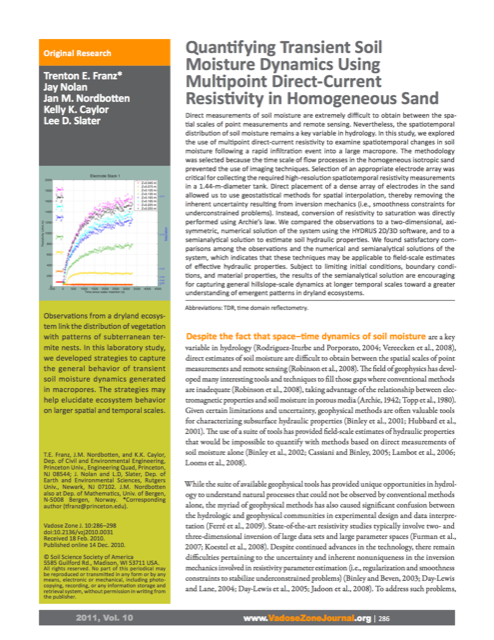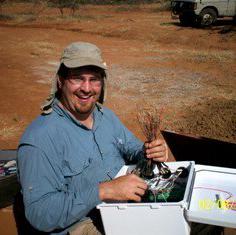Quantifying transient soil moisture dynamics using multi-point direct-current resistivity in homogeneous sand

*Franz, T., Nolan, J., Nordbotten, J., Caylor, K.K., Slayter, L. (2011) “Quantifying transient soil moisture dynamics using multi-point direct-current resistivity in homogeneous sand,” Vadose Zone Journal, vol. 10, doi:10.2136/vzj2010.0031.
Direct measurements of soil moisture are extremely difficult to obtain between the spa- tial scales of point measurements and remote sensing. Nevertheless, the spatiotemporal distribution of soil moisture remains a key variable in hydrology. In this study, we explored the use of multipoint direct-current resistivity to examine spatiotemporal changes in soil moisture following a rapid infiltration event into a large macropore. The methodology was selected because the time scale of flow processes in the homogeneous isotropic sand prevented the use of imaging techniques. Selection of an appropriate electrode array was critical for collecting the required high-resolution spatiotemporal resistivity measurements in a 1.44-m-diameter tank. Direct placement of a dense array of electrodes in the sand allowed us to use geostatistical methods for spatial interpolation, thereby removing the inherent uncertainty resulting from inversion mechanics (i.e., smoothness constraints for underconstrained problems). Instead, conversion of resistivity to saturation was directly performed using Archie’s law. We compared the observations to a two-dimensional, axi- symmetric, numerical solution of the system using the HYDRUS 2D/3D software, and to a semianalytical solution to estimate soil hydraulic properties. We found satisfactory com- parisons among the observations and the numerical and semianalytical solutions of the system, which indicates that these techniques may be applicable to field-scale estimates of effective hydraulic properties. Subject to limiting initial conditions, boundary condi- tions, and material properties, the results of the semianalytical solution are encouraging for capturing general hillslope-scale dynamics at longer temporal scales toward a greater understanding of emergent patterns in dryland ecosystems.
